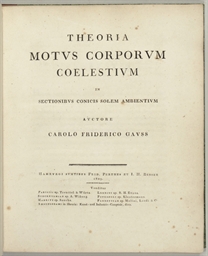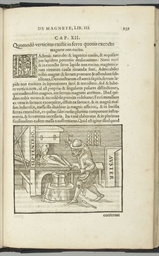"ENIGMA"-- Calculating Machine. A three-rotor Enigma enciphering machine, number A-957, with electric core end stamped B above bulb board, raised 'QWERTZ' keyboard with crackle black painted metal case (some restoration), three division window flap over rotors and concealed plugboard in the front with twelve patch leads, in carrying case, circa 1939. 10 in (26cm) wide, also with metal label "Chiffriermaschinen Gesellschaft Heimsoeth und Rinkew" on the inside of the lid -0.5in (2.5cm) high
"ENIGMA"-- Calculating Machine. A three-rotor Enigma enciphering machine, number A-957, with electric core end stamped B above bulb board, raised 'QWERTZ' keyboard with crackle black painted metal case (some restoration), three division window flap over rotors and concealed plugboard in the front with twelve patch leads, in carrying case, circa 1939. 10 in (26cm) wide, also with metal label "Chiffriermaschinen Gesellschaft Heimsoeth und Rinkew" on the inside of the lid -0.5in (2.5cm) high A three-rotor ENIGMA, the standard German electronic ciphering machine widely used in World War II. It derives from a 1919 patent of a Dutch inventor, H.A. Koch; an early design marketed by Dr. Arthur Scherbius was bought out by the German military in 1929 and placed in service. ENIGMA in several variants was used by the German Navy, the Wehrmacht, the Luftwaffe, the state railroad system, the Abwehr (intelligence) and the SS. It was designed with a complex, interchangeable series of three rotors bearing the 26-character alphabet, a "reflector" and a plugboard with movable connecting cords that connected pairs of letters. As an added precaution, the base or starting settings for the rotors was changed every 24 hours, according to pre-printed setting registers furnished in advance or supplied daily by courier. It has been calculated that the 3-rotor ENIGMA, with plugboard in use, made possible a total of 15 billion billion possible readings for each character. ENIGMA was widely regarded by the Germans as too complex to be broken, but in the 1930s a team of Polish analysts (Marian Rejewski, Jerzy Rszycki and Henryk Zygalski), made remarkable progress in working out the machine's basic system, identified its vulnerabilities and succeeded in deciphering much of the encrypted German radio traffic. Their findings, including plans for very useful mechanical devices known as "bombes," which aided in the decryption operation, were secretly passed on in 1939 to French and English investigators. An elite team of cryptoanalysts, mathematicians and engineers including Alan Turing were established in a top-secret facility at Bletchley Park. For the rest of the war that legendary team's heroic and unstinting efforts gradually accomplished the seemingly insurmountable task of deciphering an enormous volume of encrypted communications. The critical intelligence deriving from their decipherment was dubbed ULTRA and was employed cautiously but to great effect during the war; some commentators credit ULTRA with shortening the war by some two years.
"ENIGMA"-- Calculating Machine. A three-rotor Enigma enciphering machine, number A-957, with electric core end stamped B above bulb board, raised 'QWERTZ' keyboard with crackle black painted metal case (some restoration), three division window flap over rotors and concealed plugboard in the front with twelve patch leads, in carrying case, circa 1939. 10 in (26cm) wide, also with metal label "Chiffriermaschinen Gesellschaft Heimsoeth und Rinkew" on the inside of the lid -0.5in (2.5cm) high
"ENIGMA"-- Calculating Machine. A three-rotor Enigma enciphering machine, number A-957, with electric core end stamped B above bulb board, raised 'QWERTZ' keyboard with crackle black painted metal case (some restoration), three division window flap over rotors and concealed plugboard in the front with twelve patch leads, in carrying case, circa 1939. 10 in (26cm) wide, also with metal label "Chiffriermaschinen Gesellschaft Heimsoeth und Rinkew" on the inside of the lid -0.5in (2.5cm) high A three-rotor ENIGMA, the standard German electronic ciphering machine widely used in World War II. It derives from a 1919 patent of a Dutch inventor, H.A. Koch; an early design marketed by Dr. Arthur Scherbius was bought out by the German military in 1929 and placed in service. ENIGMA in several variants was used by the German Navy, the Wehrmacht, the Luftwaffe, the state railroad system, the Abwehr (intelligence) and the SS. It was designed with a complex, interchangeable series of three rotors bearing the 26-character alphabet, a "reflector" and a plugboard with movable connecting cords that connected pairs of letters. As an added precaution, the base or starting settings for the rotors was changed every 24 hours, according to pre-printed setting registers furnished in advance or supplied daily by courier. It has been calculated that the 3-rotor ENIGMA, with plugboard in use, made possible a total of 15 billion billion possible readings for each character. ENIGMA was widely regarded by the Germans as too complex to be broken, but in the 1930s a team of Polish analysts (Marian Rejewski, Jerzy Rszycki and Henryk Zygalski), made remarkable progress in working out the machine's basic system, identified its vulnerabilities and succeeded in deciphering much of the encrypted German radio traffic. Their findings, including plans for very useful mechanical devices known as "bombes," which aided in the decryption operation, were secretly passed on in 1939 to French and English investigators. An elite team of cryptoanalysts, mathematicians and engineers including Alan Turing were established in a top-secret facility at Bletchley Park. For the rest of the war that legendary team's heroic and unstinting efforts gradually accomplished the seemingly insurmountable task of deciphering an enormous volume of encrypted communications. The critical intelligence deriving from their decipherment was dubbed ULTRA and was employed cautiously but to great effect during the war; some commentators credit ULTRA with shortening the war by some two years.















Try LotSearch and its premium features for 7 days - without any costs!
Be notified automatically about new items in upcoming auctions.
Create an alert